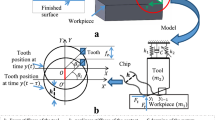Abstract
The dynamic behavior of a ball screw under a moving grinding force and the resulting ball screw surface roughness are investigated. The system includes a ball screw, a headstock, a tailstock, a steady rest, a grinding wheel, and a wheel head. Equations of motion of the system are derived through Lagrangian approach combined with global assumed mode method in this study. The transient responses of the system due to a moving force are evaluated using Runge–Kutta method. Results show that the steady rest can reduce 90% vibration in a grinding process. An equation is proposed to predict the maximum response by the cutting depth. Then we simulate the grain height distribution on the grinding wheel, considering transient response on the ball screw and the grinding wheel. Lastly, the ball screw surface roughness could be simulated via calculating the depth of all working grains. The purpose of using grinding process is that the ball screw needs fine surface roughness. The ball screw surface roughness is influenced by the grain size more than the structure numbers can be.
Similar content being viewed by others
References
Katz R, Lee CW, Ulsoy AG, Scott RA (1988) The dynamic response of a rotating shaft subject to a moving load. J Sound Vib 122(1):131–148
Lee HP (1995) Dynamic response of a rotating Timoshenko shaft subject to axial forces and moving loads. J Sound Vib 181(1):169–177
Lee HP (1996) Dynamic response of a beam on multiple supports with a moving mass. Struct Eng Mech 4(3):303–312
Abu-Hilal M, Mohsen M (2000) Vibration of beams with general boundary conditions due to a moving harmonic load. J Sound Vib 232(4):703–717
Shiau TN, Huang KH, Hsu WC (2006) Dynamic response and stability of a rotating ball screw under a moving skew load. J CSME 27(3):297–306
Shiau TN, Chen EC, Huang KH, Hsu WC (2006) Dynamic response of a spinning Timoshenko beam with general boundary conditions under a moving skew force using global assumed mode method. Int J JSME 49(2):401–410
Salonitis K, Chryssolouris G (2006) Cooling in grind-hardening operations. Int J Adv Manuf Tech 33(3–4):285–297
Li H, Shin YC (2006) Wheel regenerative chatter of surface grinding. J Manu Sci-E 128(2):393–403
Li H, Shin YC (2006) A time-domain dynamic model for chatter prediction of cylindrical plunge grinding processes. J Manu Sci-E 128(2):404–415
Li H, Shin YC (2007) A study on chatter boundaries of cylindrical plunge grinding with process condition-dependent dynamics. Int J Mach Tool Manu 47(10):1563–1572
Sadeghi MH, Haghighat H, Elbestawi MA (2003) A solid modeler based ball-end milling process simulation. Int J Adv Manuf Tech 22(11–12):775–785
Shiau TN, Chen KH, Chang JR (2009) Critical speed analysis for nonlinear effects of rotor system and ball end milling. Int J Adv Manuf Tech 44(5–6):463–475
Chen X, Rowe WB (1996) Analysis and simulation of the grinding process. Part І. Generation of the grinding wheel surface. Int J Mach Tool Manu 36(8):871–882
Singh D, Rao PV (2006) A surface roughness prediction model for hard turning process. Int J Adv Manuf Tech 32(11–12):1115–1124
Zhou X, Xi F (2002) Modeling and predicting surface roughness of the grinding process. Int J Mach Tool Manu 42(8):969–977
Salisbury EJ, Domala KV, Moon KS, Miller MH, Sutherland JW (2001) A three-dimensional model for the surface texture in surface grinding, Part 1: surface generation model. J Manu Sci-E 123:576–581
Salisbury EJ, Domala KV, Moon KS, Miller MH, Sutherland JW (2001) A three-dimensional model for the surface texture in surface grinding, Part 2: grinding wheel surface texture model. J Manuf Sci-E 123:582–590
Liu Z, Payre G (2007) Stability analysis of doubly regenerative cylindrical grinding process. J Sound Vib 301(3–5):950–962
Orynski F, Pawlowski W (2002) The mathematical description of dynamics of the cylindrical grinder. Int J Mach Tool Manu 42(7):773–780
Malkin S (1989) Theory and applications of machining with abrasives. University of Massachusetts
Author information
Authors and Affiliations
Corresponding author
Rights and permissions
About this article
Cite this article
Shiau, TN., Chen, KH., Wang, FC. et al. The effect of dynamic behavior on surface roughness of ball screw under the grinding force. Int J Adv Manuf Technol 52, 507–520 (2011). https://doi.org/10.1007/s00170-010-2731-2
Received:
Accepted:
Published:
Issue Date:
DOI: https://doi.org/10.1007/s00170-010-2731-2




